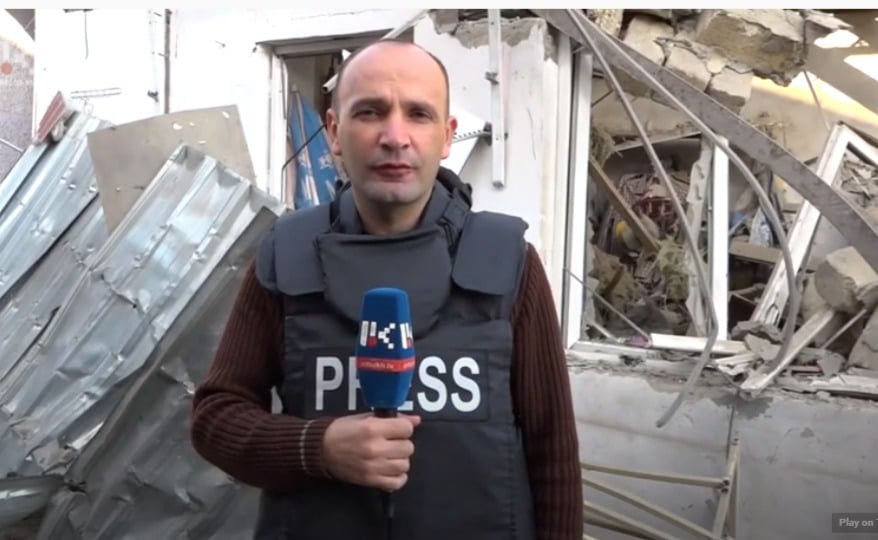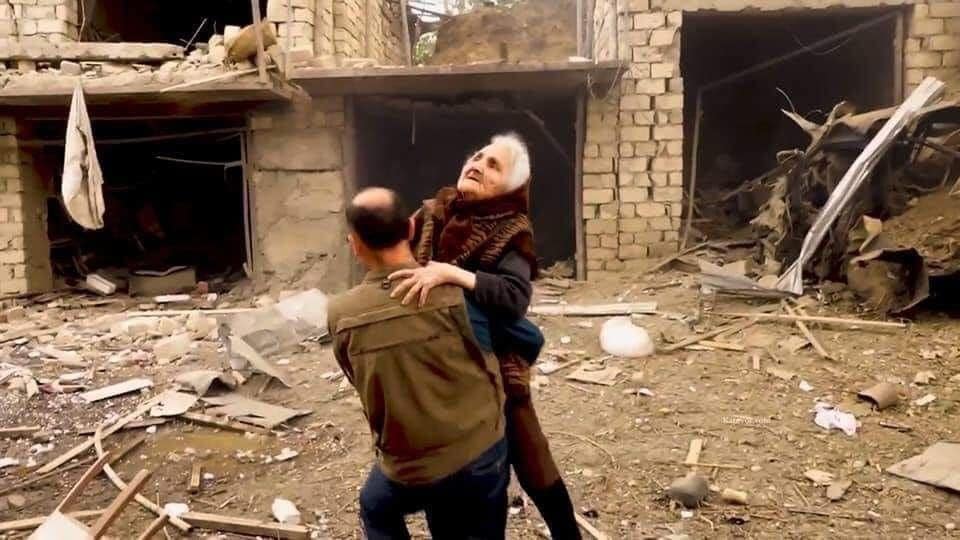
Artsakh Public Television journalist Norayr Hovsepyan has been reporting from various places throughout the war, which began on September 27, often from the front lines and shelled settlements.
He says that compared to the April war, the danger was greater, as almost all settlements were shelled․
“At that time there were at least approximate borders – a road, a place where we imagined it was safe, and in this case, the borders became more uncertain. The same danger could be felt by the employee of the Stepanakert store, the person working in his yard in Martuni and the journalist who was there to cover the event.
Norayr often, putting aside his journalistic responsibilities, came to the aid of the citizens. A photo of one such situation has been actively spread across the media․ The picture of the man hugging an old woman was seen everywhere for several days.
Norayr says that day was one of the most active days of shelling in Stepanakert. The journalistic group had gone out to tour the city. And when they stopped at the shelled building to get a general idea of the situation, they heard cries for help. Naturally, they immediately followed the tracks of the voice and found the elderly woman․
Later on, he noticed that cameraman Artavazd Grigoryan also followed him upstairs and was filming. They came to the rescue because there was a need. And this is a “normal human approach,” because wherever you are, you are a human before all else.
“We would be able to cover what happened later, maybe not with that quality and not with the same emotion, but at that moment, human life was key, the rest could be thought about later,” he said.
And he adds that every journalist in Artsakh is ready that at some point he may have to put aside his professional work and do something that has nothing to do with his profession.
“If you have gone to cover and you need help, of course, you temporarily put aside your journalistic responsibilities to do the most important work at that moment, helping people. This is not someone’s monopoly, everyone is at least spiritually ready for it.”
Besides, according to Norayr, a journalist covering a war must be ready for any development, if necessary, dress the wounds of his colleague or himself, take refuge if necessary.
“What we only imagined somewhere far away was here, in our house.”

How to work in the conditions of changing information
Working with information that changes every hour and minute in war conditions was not so easy and often time-consuming.
“Immediately before the broadcast, we were checking again what had changed in connection with this or that situation. But there were cases when for some reason the prepared material was simply not aired, for example, in the ongoing war situation it was not expedient to provide the information. Most of my colleagues approached that reality with understanding, we tried not to cause harm. That was our important principle.”
In a war, when you are one of the parties, it is difficult to stay out of propaganda, there is always an internal dispute between journalists and citizens, an internal conflict.
When war and death have come to your house and you are forced not only to work but also to live in war, how to find the fine line that will help you to stay alert?
Norayr considers this one of the most difficult issues, especially for journalists working in Artsakh, who cannot be limited to simply providing information, as working with information has many and complex implications for them. He says that the journalists from Artsakh are involuntarily on the opposite side of the trench. And whether they like it or not, it was expressed in some way ․
“The problem is to minimize it, not to violate the norms of professional ethics. But I will not hide my guilt, you can’t be completely neutral. In the end, if the other person shoots, no matter what weapon you have, you have to defend yourself.”
And protect yourself in the information field as well.
For example, if one side says, “We did not hit civilian objects,” you simply can’t keep yourself from going and saying that a civilian object was hit. But in the case of Artsakh, you can’t be satisfied with that alone. The information war involuntarily dictates its rules, good or bad is another matter, that is the reality.”
There were a lot of emotional scenes in the war videos, which showed the feelings of the people, the tense mental state, the pain and grief of loss. There were shots that caused shock or contained military secrets.
Artsakh Public Television has tried to stay away from showing footage that is not allowed by television ethics and is prohibited by various international conventions.
Norayr says there was no need to look for emotional shots. “When you take a picture of someone who was standing an hour ago but now stands in front of a ruined house, I do not think there is a need to look for a separate emotion. There was a house, there is no house, that man is standing next to his house, hanging his head ․․․ The war is so cruel that it is not necessary to look for additional details to draw out emotions, it is enough to record what is there.”
The life of a war-torn person collapses before his eyes, and loss and grief often blind or force him to think. And he may not want to give an interview at all, because at that moment he has much more serious problems, he is in a more difficult psychological and physical condition, he is not ready to speak in front of the camera.
According to Norayr, one should approach with understanding, if people do not want to talk about themselves. But at the same time, the journalist must record and validate reality.
“That golden mean must be found. Make sure that we do not hurt that person too much and the information does not suffer much. I try not to create material at the expense of people’s emotions,” he said.
And he admits that he understands and shares the emotions of the heroes of his material well, which is inevitable, but he tries to minimize his attitude in the reports․
“The most memorable thing was in the positions, the interactions with the volunteers and conscripts… Do you know which one was the happiest moment? The fact that a week later I saw the same group in the same position․ They had no losses.”
“Covering a war is cruel. As a journalist, you think that you must quickly make public what you know, but then you give up that idea. We must always take into account that by disclosing information, we must bring more benefit or harm, as a result of which no one will suffer, you will not strike anyone (also physically). It is important to maintain the principle of non-harm. “
According to him, Artsakh Public TV tried to help people imagine the situation and what they should do. And if there were inspiring pieces of material, then they were “emphasized a little more.”
“The main source of information was the official one. We tried to ensure that the rest of the information did not receive a negative response, but at the same time did not deceive the audience. It’s also not like the task was set to show that everything is fine,” said Norayr.
And he adds that during a war, not everything can be good.
Anahit Danielyan


Add new comment
Comments by Media.am readers become public after moderation. We urge our readers not to leave anonymous comments. It’s always nice to know with whom one is speaking.
We do not publish comments that contain profanities, non-normative lexicon, personal attacks or threats. We do not publish comments that spread hate.